.568.jpg)
The coastline of the ‘Patagonian Sea’ covered with seabirds and seals. Photo by: W. Conway.
Claudio Campagna will be speaking at the Wildlife Conservation Network Expo in San Francisco on October 1st, 2011.
With wild waters and shores, the Patagonia Sea is home to a great menagerie of marine animals: from penguins to elephants seals, albatrosses to squid, and sea lions to southern right whales. The sea lies at crossroads between more northern latitudes and the cold bitter water of the Southern Ocean, which surround Antarctica. However the region is also a heavy fishing ground, putting pressure on a number of species and imperiling the very ecosystem that supplies the industry. Conservation efforts, spearheaded by marine conservationist Claudio Campagna and colleagues with the Wildlife Conservation Society (WCS), are in the early stages. Campagna, who often writes about the importance of language in the fight for preservation, has pushed to rename the area to focus on its stunning wildlife.
“We invented the term ‘Patagonian sea’ in an attempt to shift the focus of attention towards the diversity of marine species: the wildlife spectacles in and around the sea,” explains Campagna in a mongabay.com interview. “The geographic name given to this ocean is the South West Atlantic, but the Argentines like to call it the Argentine Sea. The Argentine Sea highlights a jurisdictional perspective. The Food and Agriculture Organization (FAO), in turn, refers to it as a part of FAO Area 41, a fishing site. Geographers care about geography, nations about sovereignty and fishermen about fishing. Well, why not conservationists, who care about biodiversity, give the area a name as a statement as well?”
The name ‘Patagonian Sea’ provides the sense of a marine counterpart to the wild terrestrial region of Patagonia, renowned for dramatic and untouched landscapes.
.360jpg) Claudio Campagna and a juvenile elephant seal with a satellite tag. Photo by: V. Zavattieri. |
Campagna and colleagues applied a tool developed by WCS, known as a Landscape/Seascape species approach, to help identify critical species that would multiply the conservation effort to protect an entire ecosystem. Currently they now working to bring other conservation groups on board.
“We created a Forum of NGOs for the conservation of the Patagonian Sea that brings together representatives of the conservation ideal. NGOs are slowly learning to work together towards the same aim. We created a strong base of scientific data to root conservation action in species knowledge. When “our sector”—that of the conservation community—evolves to be stronger and wiser, then we may try our thoughts on other stakeholders and increase constituency. It is a process of building that precedes the action,” Campagna explains.
While the process of conserving the Patagonian Sea is complicated, the threats to the region are obvious, says Campagna.
“Simple: overfishing first, then overfishing. If we need a third threat: overfishing. Fourth to tenth: overfishing. Then come the many other negative consequences related to fishing: bycatch is one of the worse. I often worry about bycatch more than overfishing because I understand greed better than perversity, bycatch is perverse. Other threats: pollution, of course, of all kinds imaginable (we should not forget noise), and introduced species, certainly.” Ever the philosopher, Campagna adds that these threats—and those facing natural environments around the world—ultimately stem from humankind’s myopia.
“The major threat is that we do not deeply understand that these threats cannot keep going. Our behavior, our beliefs are a threat; the incapacity to change our course of action in due time, after overwhelming evidence, is strong. Conservation is not difficult to achieve in theory, it is just resisted in practice. This is in part because economists run the world and few understand the consequences of their paradigms.”
.360.jpg) Overfishing in the Patagonian Sea. Photo by: Rev Puerto. |
Not just interested in the on-the-ground issues of conservation, Campagna wants to change the way people view conservation and nature. He says that the relentless focus on ‘sustainable development’ by conservation NGOs has hurt the cause.
“Conservation language today requires being politically correct or funds will not be there. ‘Sustainable development’ is the archetypal concept in this discourse. If you fail to say or mention these magic two words in a speech or a text, it may well be that you have no chance to attract an audience. Conservation today is a lot about natural capital, natural resources and ecosystem services. It is much less about tranquility, inspiration, happiness, or beauty. The name of the winning game is to show the value of natural resources; the discourse is to provide a reason for Nature to exist. I oppose that view; it is not taking us anywhere.”
Instead, Campagna argues that the natural world should be saved for its intrinsic value, and that conservationists must again learn to express and share the wonders of nature, fighting for an ideal that has largely been obfuscated in the attempt to make the natural world fit the tyranny of economists.
“We need first to move conservation values away from economics and more into the realm of ideals. For example, do we need to explain why slavery is not good? Do we need to explain why the world is not trying to come up with ‘sustainable slavery’? After all, there is a business in this. Slavery is rejected ‘from the guts’, with no further need to explain why. […]. Why is conserving the diversity of life so different? The crisis of biodiversity cannot be placed in the same bag with markets crashing or economic bubbles. Is it too difficult to accept that an economic cost may not be the critical issue? […] The conservation community must change the way it thinks about conservation. Too much camouflage of intentions, too much concealing of ideals. We have a vision of what the world should be, a strong one. We have the right to work for that vision, no compromises, just going for it.”
.568.jpg) Magellanic penguins. Photo by: L. Campagna. |
Aside from his day job of working to save an entire sea, Campagna is also the scientific consultant of the popular, and always surprising, Green Porno with Isabella Rossellini.
“It is the most creative, funny, daring, imaginative, original and charming communication project I have ever been involved with. It is about conveying messages with alternative perspectives and tools. It is being surreal with science,” says Campagna, who calls Rossellini “the conservationist of the future, a person that combines knowledge, know how, sensitivity, humor, creativity and confidence to advance her ideas despite what most may think as the ‘appropriate’ way to speak and think.”
In a September 2011 interview Claudio Campagna discusses his work with elephant seals, the beauty of the Patagonian Sea, and why conservationists must reconnect with their ideals.
Campagna will be presenting at the up-coming Wildlife Conservation Network Expo in San Francisco on October 1st, 2011, an event which will be headed by Jane Goodall.
INTERVIEW WITH CLAUDIO CAMPAGNA
.568.jpg)
Claudio Campagna tagging a massive elephant seal. Photo by: Jim Large.
Mongabay: How did you decide to leave your medical career as a doctor and become a marine conservationist?
Claudio Campagna: Doctors care about humans, conservationists do too, perhaps more indirectly. Conservationists have a side as doctors of Nature, a sad perspective, as it implies that Nature is injured or diseased—and it is. Conservation, however, is only partially about humans. I disagree that conservation is ‘for’ humans. I think conservation is for biodiversity: the priority is biodiversity, conserving biodiversity may even be above human needs. If one places humans on top, no matter what is buried underneath, one may be supporting a wrong set of principles and values. No doubt, that will reflect negatively on us. Humans are lost outside the natural world; the human mind will be lost, and the sense of being human will be irrecoverable. A conservationist needs to have an ecosystem view of the human mind. Doctors often address humans in their “components”, understand little of the whole, and are happy with that. Conservationists, however, must depart from the whole; simplification is not possible. Conservation is about a functioning individual and a happy society, and vice- versa. Unfortunately, today, conservationists are often just problem-solvers.
PATAGONIAN SEA
.568.jpg)
Albatross along the Patagonian Sea. Photo by: G. Harris.
Mongabay: What makes the Patagonian sea unique?
Claudio Campagna: Perhaps, the fact that it does not exist. Patagonia is the land, but we invented the term “Patagonian sea” in an attempt to shift the focus of attention towards the diversity of marine species: the wildlife spectacles in and around the sea. The geographic name given to this ocean is the South West Atlantic, but the Argentines like to call it the Argentine Sea. The Argentine Sea highlights a jurisdictional perspective. The Food and Agriculture Organization (FAO), in turn, refers to it as a part of FAO Area 41, a fishing site. Geographers care about geography, nations about sovereignty and fishermen about fishing. Well, why not conservationists, who care about biodiversity, give the area a name as a statement as well? The Patagonian Sea sustains many species of marine birds and mammals that are key conservation species. It is also a place of extraordinary abundance of food and of marine species, often less appreciated as wildlife, such as most fish and invertebrates. The Patagonian sea encompasses the most important foraging and migration areas for penguins, sea lions, albatrosses and seals, among others. Top predators are distributed widely in the sea, but not randomly.
Mongabay: What are the major threats to the species in the sea?
.360.jpg) Argentine squid. Photo by: C. Verona. |
Claudio Campagna: For the ocean in general, simple: overfishing first, then overfishing. If we need a third threat: overfishing. Fourth to tenth: overfishing. Then come the many other negative consequences related to fishing: bycatch is one of the worse. I often worry about bycatch more than overfishing because I understand greed better than perversity, bycatch is perverse. Other threats: pollution, of course, of all kinds imaginable (we should not forget noise), and introduced species, certainly. But why do we list threats? Is there anything new that the educated world does not know already?
The major threat is that we do not deeply understand that these threats cannot keep going. Our behavior, our beliefs are a threat; the incapacity to change our course of action in due time, after overwhelming evidence, is strong. Conservation is not difficult to achieve in theory, it is just resisted in practice. This is in part because economists run the world and few understand the consequences of their paradigms. Besides, they will not be held responsible for straying the world in the wrong direction.
Finally, locally there is a lack of awareness among Argentines regarding their ocean. Argentina is a nation that evolved around the pampas landscapes, but today it is much more than that. It is very important to work in communicating the message that there is a big ocean that should be managed to benefit many more of us than the small proportion of the Argentine population involved in the fisheries.
Mongabay: What is the Landscape Species Approach (LSA)?
.568.jpg) Commerson’s dolphin . Photo by: G. Coll. |
Claudio Campagna: A methodology to plan conservation for species across habitat. Any ecosystem has hundreds, thousands of interdependent species. Yet, human and funding resources are limited. The abundant money that exists in this world is never available for conservation. What to do then? Prioritize is one answer. Some conservationists prioritize according to endemic species, variety of species, representative habitats, etc. The Wildlife Conservation Society (WCS) has its own perspective: conserve the landscape by choosing those species that best represent the needs of all the rest. If you manage an area with these set of landscape/seascape species, you may assume you are doing OK for the entire system. It is a management approach rooted in ecological underpinnings with a species’ focus.
One member our team, Valeria Falabella, applied many of the tools developed by the Living Landscapes Projects of WCS in an attempt to enhance the understanding of the working of the systems and the conservation priorities. She also developed, with the cooperation of dozens of scientists around the world, the Atlas of the Patagonian Sea: Species and Spaces, a unique integration of satellite tracking data for 16 species of marine birds, mammals and turtles.
Mongabay: Have any of the findings of your LSA study been used in management of the Patagonian sea?
.360.jpg) South American sea lions at the Punta Loma rockery. Photo by: JF Thye. |
Claudio Campagna: No! That would be almost a miracle. When a good, rational approach is immediately applied to management? Rarely, and even more rarely where I come from. The LSA indicates, for example, that Argentine squid is a seascape species. When I mentioned this finding to the fishing authorities they laughed for half an hour. They are wrong: ecologically squid are a crucial species. They just could not get that idea. Changing perspectives is the most difficult goal; persistence is required to honestly create awareness without the propagandistic paraphernalia that usually accompanies big changes in attitudes. We must keep adding grains of sand to stop the grinder. Persistence is elementary; slowly the world is understanding biodiversity.
Mongabay: Do you believe this approach could be used elsewhere in the world?
Claudio Campagna: Yes. The approach is really useful; it helps organize data and thoughts, and helps decide actions and priorities. Nothing wrong with the approach, as we can say of many other intelligent perspectives available to improve management. The problem is different: who says that “we” want to improve management? Many fisheries, for example, are heavily subsidized. They make very little economic sense in a world of markets. If fisheries would have to pay for the environmental costs they cause—including those said to be “sustainable”—from garbage to entangled turtles, virtually nobody could afford to eat marine fish. But then the subsidy comes to the rescue; money that is not available, we are told, to support any really important societal needs is available to a group that lobbies well and hard. We all pay for the luxurious diet of many developed countries. There is no money for conservation but there is plenty to make it possible for Spain to cheaply consume shrimp—just one example.
Mongabay: How do you work toward the conservation of biodiversity in the Patagonian sea?
.360.jpg) A Critically Endangered leatherback sea turtle netted by ghost fishing, i.e. injured or killed by nets discarded in the sea by fishermen. Photo by: A. Fallabrino. |
Claudio Campagna: I do more and more communication these days. It’s difficult to tackle the main threats; we need to prepare the ground first. When I started the WCS-Sea and Sky project, I wanted to solve basic problems that translated into threats: overfishing, entanglement, bycatch, the usual threats. It proved to be impossible. The civil society is weak, not well organized and does not have the resources to change the course of action, at least not in Argentina. The fishing companies are rarely environmentally friendly. And the government exists to facilitate development at any cost. Our conservation message was ripe and supported, but the institutional and societal context was not. The consequence has been failure until I learned to take several steps back in order to create the context to plant our seed. For example, we created a Forum of NGOs for the conservation of the Patagonian Sea that brings together representatives of the conservation ideal. NGOs are slowly learning to work together towards the same aim. We created a strong base of scientific data to root conservation action in species knowledge. When “our sector”—that of the conservation community—evolves to be stronger and wiser, then we may try our thoughts on other stakeholders and increase constituency. It is a process of building that precedes the action. Sea and Sky has also promoted the conservation of the open ocean, the project was originally named “A Park of Sea and Sky”, suggesting that the open ocean could also be, for example, a National Park.
ELEPHANT SEALS
.568.jpg)
Campagna with male elephant seal. Photo by: G. Harris.
Mongabay: What drew you to study southern elephant seals?
Claudio Campagna: They were there—and this is true, because “there” means the coast of Patagonia, one of the most beautiful places I have ever seen, perhaps the most beautiful. I loved to observe animal behavior, and seals are particularly good because, on land, one can observe them at leisure. A good model to study behavior, lots of scientific questions, a great place to do the work and live: what else would one need to make up one’s mind?
Mongabay: How do you study such large and potentially dangerous animals?
Claudio Campagna: Well…an elephant seal, dangerous? Yes, perhaps…I am really much more worried about being robbed in a street of Buenos Aires. If you do not disturb the elephant seals, they will not bite you. Now, if one wants to tag them, paint them with names, attach instruments on their head and back, as I have done over the years, then yes, one can be bitten. I have never been, I guess I was careful and lucky. Whoever studies large animals in the wild accepts that they to invade the animals’ lives, a heavy invasion. This may have consequences. Fortunately, elephant seals seem to tolerate a bit of that. If one keeps pushing…then the danger is the human attitude.
Mongabay: What have you discovered about the behavior of the elephant seal?
.360.jpg) Young elephant seal. Photo by: V. Falabella. |
Claudio Campagna: Nothing really that has not been known from other populations, besides the Patagonian colony of Península Valdés, where I work. We did do some work for the first time, of course, such as studying elephant seal paternity using DNA fingerprinting like it is being done with humans.
My purpose, however, was not to discover novel things, it was to be actively involved in protecting the Patagonia population of seals. Science is not only about discovery; it can be a tool for conservation too. People care about what they know better. We may not translate immediately what we know into protection, but in the long term we, humans, tend to learn and care. I wanted to facilitate that process in the area I had access to and with the species I like.
Mongabay: The species is listed as Least Concern by the IUCN Red List. Are they facing any threats currently?
Claudio Campagna: Sure. You may go from Least Concern to extinction easily. Think of the passenger pigeon. Least Concern is an unstable concept. Least Concern means: “I have so much to worry now that I need a break; this species will have to wait”. Then, when you catch up, and want to find out how the species has been doing, it may be too late. We live in a changing world in which no environment is safe, no species is safe, not even ours, despite being in the most extreme of the Least Concern category of all vertebrates.
LANGUAGE AND CONSERVATION
.568.jpg)
Southern right whale breaching in the Patagonian Sea. Photo by: V. Falabella.
Mongabay: You describe the vision of most conservation groups as ‘utilitarian’. What do you mean by this?
Claudio Campagna: Conservation language today requires being politically correct or funds will not be there. ‘Sustainable development’ is the archetypal concept in this discourse. If you fail to say or mention these magic two words in a speech or a text, it may well be that you have no chance to attract an audience. Conservation today is a lot about natural capital, natural resources and ecosystem services. It is much less about tranquility, inspiration, happiness, or beauty. The name of the winning game is to show the value of natural resources; the discourse is to provide a reason for Nature to exist. I oppose that view; it is not taking us anywhere.
Mongabay: What’s wrong with conservation organization’s focus on ‘sustainable development’?
Claudio Campagna: What is wrong with praying to the oracle when you have to lead men to a battle? One is free to try magic in whatever decision concerns the individual, but it seems wrong to decide the fate of biodiversity based on the wrong approach. Governments seem to believe we can keep Nature going despite more consumption, more people, more resources, growth, use, exploitation. It is not possible. Technology may help, but it is not a solution; it is a tool that does not work in every case—certainly not to bring back an extinct species. Sustained development means expansion of use, means appropriation of Nature forever. Is it really difficult to accept that the intention may have been good but the implementation failed? The sustainable development concept is about development that, by definition, is about expansion, increase, with Nature supporting it…no way this can be kept going. It does not even make common sense.
Mongabay: What should instead be the focus?
.360.jpg) A pair of black browed albatross in the Patagonian Sea. Killed en masse by trawl and longline fishing, this species is listed as Endangered by the IUCN Red List. Photo by: Jim Large. |
Claudio Campagna: I can tell you my focus: beauty, conciliation, well-being, happiness. These values are underestimated but are the most relevant. These are not mystical values; these are the values we seek when we, for example, go on vacation, when we visit a National Park. Those times are the best in life: family time, learning time, pleasure time. If one wants to translate that into economics, it is possible, of course, but it is more about health; it is about quality of life and its effect on individual survival. We spend money in educating people to be healthy, but we are not ready to use those funds for conservation purposes. This is wrong. My values, today, may not be in the market…but it is a matter of time before countries will be valued not based on their financial strength but on the quality of their Nature. Brazil is killing the hen laying the golden eggs by turning the Amazon into land for cattle, miners and agriculturalists. Same with Argentina and soy. We need to set aside as much Nature as possible until we catch up with our learning.
Mongabay: What are the intrinsic values of nature?
Claudio Campagna: This is not an issue that should be posed as a question. It is a discourse confusion, it is like pointing at an “object” that is not an object. It is as if one is asking: what is the intrinsic value of life? Or even better: what is the intrinsic value of your life? And of that of the beings you love? One may grasp the irrelevance of the question when pushed to the absurd position to have to justify one’s own existence. Nature is not less than our own existence. Intrinsic values do not have to be defined; they are built into our being, as the intrinsic value of breathing air for a human being.
Mongabay: How does one convince the public that nature has value beyond resource extraction?
.360.jpg) By-catch: species that are accidently killed by industrial fishing methods. Photo by: A. Fallabrino. |
Claudio Campagna: We cannot convince the public. Education can modify behavior, but you cannot become an opera fan just because somebody interprets opera for you. One is or is not, from the beginning. Humans are not built to worry about Nature. To change attitudes is an internal process, a personal path, more than the consequence of a demonstration. Place a society in a situation to decide between crazy consumption and precaution towards Nature and I bet most will prefer a careful attitude. Today, economists and communicators are not presenting us with alternatives. They tell us what we are and what we want. They are wrong.
Mongabay: Are there any organizations you can point to that view nature beyond its usefulness to humans?
Claudio Campagna: I would say most conservation organizations do…at least, the people in the organizations do. The language, the discourse they use is not aligned with what most organizations really represent. The Wildlife Conservation Society is a bunch of committed naturalists, extraordinarily well-trained in the sciences, devoted, articulated in policy and social issues, sensitive to social demands, human well-being, management challenges, economics applied to a broad variety of circumstances and places. Yet, you get their best happy faces when they see an animal, a plant or a landscape that takes their breath away. That is the fuel. Unfortunately we have been tamed to put the engine aside and work on batteries…not very clever.
ADDITIONAL PROJECTS
.568.jpg)
Campagna with Isabella Rossellini, creator of Green Porno, and an elephant seal. Photo by: Jody Shapiro.
Mongabay: What is ‘Green Porno’ and what role do you play in the short films?
Claudio Campagna: It is the most creative, funny, daring, imaginative, original and charming communication project I have ever been involved with. It is about conveying messages with alternative perspectives and tools. It is being surreal with science. I have been a scientific advisor to a few of the Green Porno episodes, although my role was better described as the person who helped Isabella Rossellini make decisions on details. Isabella does not need a scientist to tell her what is right or wrong, she reads more broadly than the average scientist I know. She is the conservationist of the future, a person that combines knowledge, know how, sensitivity, humor, creativity and confidence to advance her ideas despite what most may think as the “appropriate” way to speak and think.
Mongabay: How does this unique show give attention both to the wild side of nature and the conservation side?
Claudio Campagna: Isabella is a conservationist. It was easy to talk to her and find conservation messages to convey. She starts with the biology. She finds the attractive sides of the biology of creatures, aspects that would elicit surprise. Then she acts out the animals, particularly the reproductive behavior or the courtship of the species, the most relevant aspect of sexual selection and of life. She asks, if I were this animal, how would I feel? What would I fear? And a new world opens up… As virtually any species one can imagine is somewhat affected by the failure of sustainable development, there is always a chance to insert a conservation approach.
Mongabay: Will you tell us about your children’s book?
.360.jpg) Elephant seals. Photo by: W. Conway. |
Claudio Campagna: Dr. Divague, the character of the book, was born as a fun project: writing rhymes in Spanish to describe the behavior of seals and the research around them. My wife, Victoria Zavattieri, knows how to use humor to express an idea. She is similar to Isabella in this sense. In fact, she worked with Isabella in some details of Green Porno. Vicky and her sister, Eugenia, know how to illustrate a scene, create a character, inject life in it and make it worth our love. I am better at creating an idea, supporting the story with words, pushing it to the end. And Dr. Divague was born like that, as a consequence of natural abilities set free. Best book I helped write and will, most likely, write myself.
Mongabay: How do we make people in awe of nature once again?
Claudio Campagna: I believe the word “awe” means fear, wonder and also respect, right? If so, it would be wise to fear and respect Nature, as diseases and catastrophes often originate in it. It would be wise to fear a crisis of biodiversity, as we do not know what it may mean for us, beyond limitation of resources and opportunities. But we should not discard admiration and compassion to energize a change of attitudes. From my perspective, however, we need first to move conservation values away from economics and more into the realm of ideals. For example, do we need to explain why slavery is not good? Do we need to explain why the world is not trying to come up with “sustainable slavery”? After all, there is a business in this. Slavery is rejected “from the guts”, with no further need to explain why. Governments must deliver, institutions must deliver, because this is what people want. Why is conserving the diversity of life so different? The crisis of biodiversity cannot be placed in the same bag with markets crashing or economic bubbles. Is it too difficult to accept that an economic cost may not be the critical issue? Can we repair an extinction? Nature has a lot to do with economic well-being; it would be stupid to deny that. I am just saying that changing attitudes requires moving nature conservation from the value and discourse neighborhoods where it has been cornered today. The conservation community must change the way it thinks about conservation. Too much camouflage of intentions, too much concealing of ideals. We have a vision of what the world should be, a strong one. We have the right to work for that vision, no compromises, just going for it.
.568.jpg)
Claudio Campagna tagging elephant seal. Photo by: Jim Large.
.568.jpg)
The Argentine squid fishery. Photo by: C. Verona.
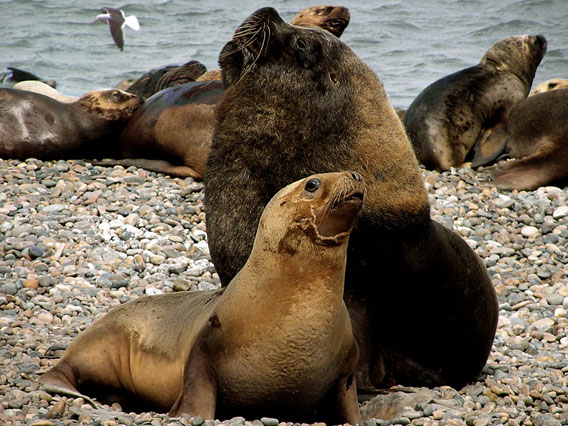
South American sea lion couple. Photo by: Claudio Campagna.
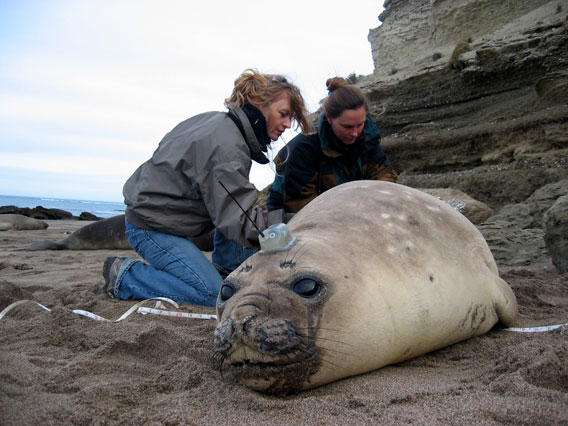
Victoria Zavattieri and Marcela Uhart from WCS tagging elephant seal. Photo by: Claudio Campagna.
.568.jpg)
King penguin. Photo by: V. Falabella.
.568.jpg)
Elephant seal suffers from entanglement. Photo by: Victoria Zavattieri.
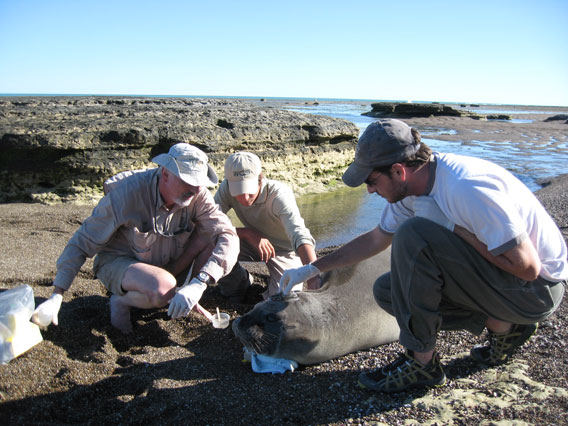
Campagna and team tag elephant seal. Photo by: Victoria Zavattieri.
.568.jpg)
Imperial cormorant in the Patagonian Sea. Photo by: Victoria Zavattieri.
.568.jpg)
Dolphins are a common victim of industrial fishing. Photo by: P. Bordino.
.568.jpg)
South American sea lion rockery. Photo by: Victoria Zavattieri.
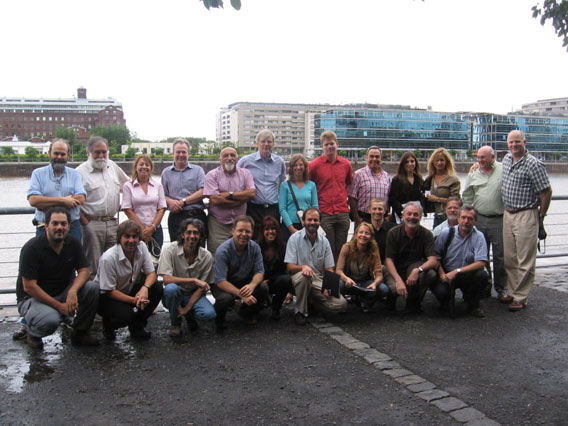
Participants in Patagonian Sea Landscape Species Approach (LSA) forum. Photo by: Victoria Zavattieri.
.568.jpg)
Campagna with elephant seal. Photo by: J. Shapiro.
.568.jpg)
Elephant seal colony in the Patagonian Sea. Photo by: Jim Large.
Related articles
The ocean crisis: hope in troubled waters, an interview with Carl Safina
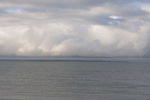
(02/07/2011) Being compared—by more than one reviewer—to Henry Thoreau and Rachel Carson would make any nature writer’s day. But add in effusive reviews that compare one to a jazz musician, Ernest Hemingway, and Charles Darwin, and you have a sense of the praise heaped on Carl Safina for his newest work, The View from Lazy Point: A Natural Year in an Unnatural World. Like Safina’s other books, The View from Lazy Point focuses on the beauty, poetry, and crisis of the world’s oceans and its hundreds-of-thousands of unique inhabitants. Taking the reader on a journey around the world—the Arctic, Antarctic, and the tropics—Safina always returns home to take in the view, and write about the wildlife of his home, i.e. Lazy Point, on Long Island. While Safina’s newest book addresses the many ways in which the ocean is being degraded, depleted, and ultimately imperiled as a living ecosystem (such as overfishing and climate change) it also tweezes out stories of hope by focusing on how single animals survive, and in turn how nature survives in an increasingly human world. However, what makes Safina’s work different than most nature writing is his ability to move seamlessly from contemporary practical problems to the age-old philosophical underpinnings that got us here. By doing so, he points a way forward.
Ocean prognosis: mass extinction
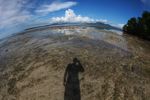
(06/20/2011) Multiple and converging human impacts on the world’s oceans are putting marine species at risk of a mass extinction not seen for millions of years, according to a panel of oceanic experts. The bleak assessment finds that the world’s oceans are in a significantly worse state than has been widely recognized, although past reports of this nature have hardly been uplifting. The panel, organized by the International Program on the State of the Ocean (IPSO), found that overfishing, pollution, and climate change are synergistically pummeling oceanic ecosystems in ways not seen during human history. Still, the scientists believe that there is time to turn things around if society recognizes the need to change.
Russia and Norway carve up wildlife-rich Arctic sea for fossil fuels
(06/09/2011) As climate change melts the Arctic sea ice, nations are rushing to carve up once-inaccessible areas for oil and gas exploitation, industrial fishing, and shipping routes. Now, BBC reports that Russia and Norway have essentially agreed to split the Arctic’s Barents Sea in half —one of the region’s richest in biodiversity and ecological productivity—for industrial exploitation.
Longline fishing still drowning over a quarter million seabirds every year
(06/08/2011) A new analysis estimates that longline fisheries are still decimating seabirds, even after years of efforts to mitigate deaths. According to a study in Endangered Species Research around 300,000 seabirds are drowned by longline fisheries as bycatch. Attracted by bait on the longline—sometimes measuring hundreds of miles as it trails on the surface behind a boat—birds are often hooked and drowned.
(04/18/2011) One of the world remotest communities, the UK’s Tristan da Cunha archipelago, has come together to save 4,000 endangered penguins following a devastating oil spill, reports the Guardian. Last month a freighter ran aground on Nightingale Island releasing 1,500 tons of oil, potentially devastating the local population of northern rockhopper penguins (Eudyptes moseleyi), which are listed as Endangered by the IUCN Red List. However, fortunately for the penguins, the tiny community of 260 people living on the Tristan da Cunha archipelago were unwilling to give up on the oiled birds.
Noise in oceans leads to ‘severe acoustic trauma’ in octopus, squid
(04/12/2011) Researchers have documented for years how noise pollution impacts dolphins in whales, but a new study in Frontiers in Ecology and the Environment finds that even low intensity noise can severely injure cephalopods, which include octopus, squid, and cuttlefish. The injuries are bad enough to possibly lead to stranding and death, thereby providing a feasible explanation for a number of recent strandings, including giant squid washing ashore in Spain.
Antarctic penguins losing to climate change through 80% krill decline
(04/11/2011) Climate change has hit species of Antarctic penguins by causing a staggering decline in their prey: krill. A new study in the Proceedings of the National Academy of Sciences (PNAS) has found that both chinstrap penguins (Pygoscelis antarcticus) and Adélie penguins (Pygoscelis adeliae) have seen their populations decline likely do to less krill, instead of habitat changes. Since 1970 krill populations have fallen by 80% in the Southern Ocean surrounding Antarctica. Because krill require sea ice to reproduce, shrinking sea ice from climate change has made it more difficult for them to breed.
New seabird discovered, first in 55 years
(03/23/2011) Stephen Maturin, if he were not fictional, would be delighted. A new seabird has been discovered by an international expedition headed by one of the world’s top seabird-experts, Peter Harrison, after he received photos from vacationing birders of an unusual looking storm petrel off the coast of Chile.
Photos: penguins devastated by oil spill
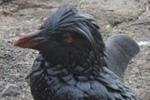
(03/22/2011) Disturbing photos show northern rockhopper penguins (Eudyptes moseleyi) hit hard by an oil spill from a wrecked cargo ship on Nightingale Island in the Southern Atlantic. Already listed as Endangered by the IUCN Red List, the oil spill threatens nearly half of the northern rockhopper population according to BirdLife International. Already conservation workers say ‘hundreds’ of penguins have been oiled. Located the remote Southern Atlantic, Nightingale Island is a part of the UK’s Tristan da Cunha archipelago. The island’s are home to a variety of birdlife, including species that survive no-where else but on the archipelago.
Hundreds of endangered penguins covered in oil after remote spill
(03/21/2011) Conservation workers have found hundreds of oiled northern rockhopper penguins (Eudyptes moseleyi) after a cargo vessel wrecked on Nightingale Island, apart of the UK’s Tristan da Cunha archipelago. Northern rockhopper penguins are listed as Endangered by the IUCN Red List. According to a press release by BirdLife International, the spill threatens nearly half of the world’s northern rockhopper population.
Arctic fish catch vastly underreported (by hundreds of thousands of metric tons) for 5 decades
(02/07/2011) From 1950 to 2006 the United Nation Food and Agriculture Agency (FAO) estimated that 12,700 metric tons of fish were caught in the Arctic, giving the impression that the Arctic was a still-pristine ecosystem, remaining underexploited by the world’s fisheries. However, a recent study by the University of British Colombia Fisheries Center and Department of Earth and Ocean Sciences throws cold water on this widespread belief. According to the study, published in Polar Biology, the total Arctic catch from 1950 to 2006 is likely to have been nearly a million metric tons, almost 75 times the FAO